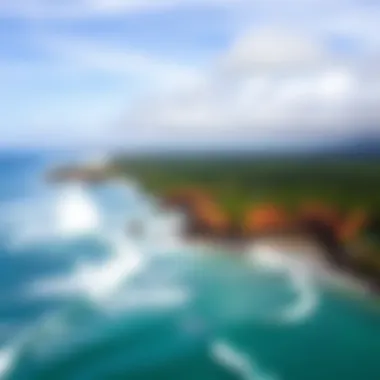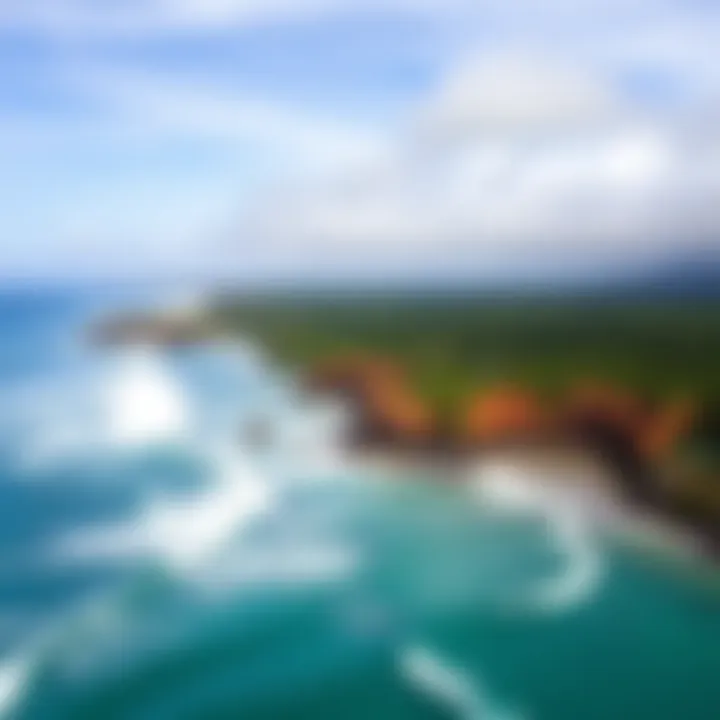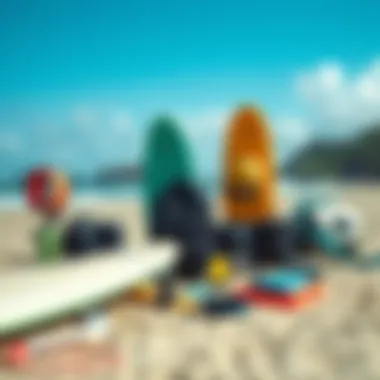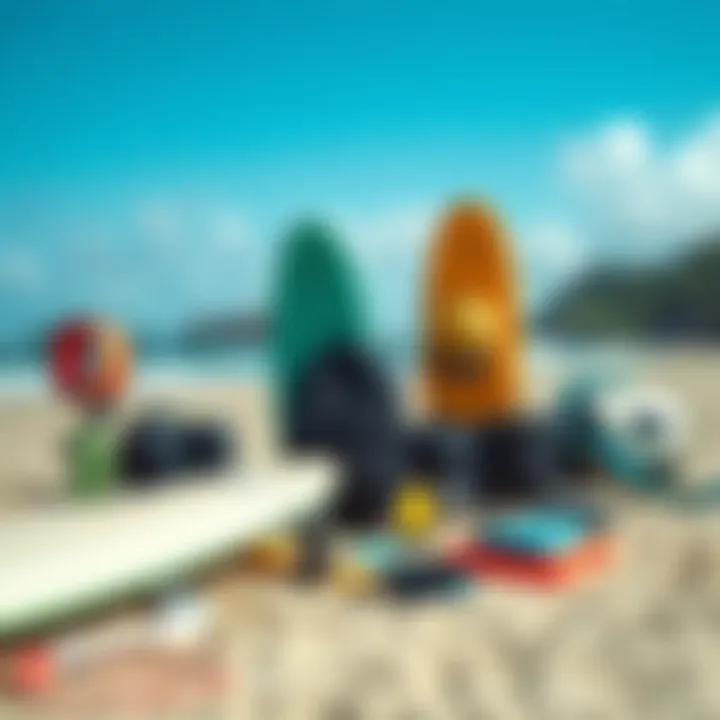Discovering the Surf Culture of Osa Peninsula


Intro
Nestled between lush rainforests and crystal-clear waters, the Osa Peninsula is a hidden gem for surfers looking to carve their paths on waves that vary in size and shape. Whether you're a novice surfer catching your first wave or a seasoned pro looking to showcase your skills, this coastline possesses a myriad of surf spots that cater to every skill level. The unique geography of Osa creates a diverse range of surf conditions; from mellow beach breaks to more challenging reef breaks, each spot offers surfers something truly distinct.
Surfing here is not just about the sport, it’s also an invitation to connect with the surrounding environment. The region boasts rich biodiversity, making it a prime locale for those who appreciate nature. However, with this privilege comes a responsibility to engage in sustainable practices. This guide aims to enlighten surfers about the surf culture, share essential techniques, recommend gear, and encourage environmentally-conscious surfing in this breathtaking locale.
In the following sections, we will deep dive into the essential techniques needed to ride Osa’s waves, recommend must-have gear, and explore the ecological impact of surfing. So let’s paddle out into the world of Osa Peninsula surfing.
Prolusion to Osa Peninsula Surfing
The surf scene in the Osa Peninsula is not just a tale of waves and winds; it’s a vibrant aspect of the broader culture of this remote region in Costa Rica. With its unique geographical features and pocket of history, this area boasts some of the most remarkable surf conditions on the planet. Surfers from various backgrounds flock here, drawn by the promise of adventure, camaraderie, and surprisingly untouched natural beauty. This section lays the groundwork for understanding why Osa Peninsula is a must-visit for any surfing enthusiast.
Geographical Overview
Nestled between the Pacific Ocean and lush tropical rainforests, the Osa Peninsula is a natural wonder. It's divided into a series of ideal surf spots, each with its distinct characteristics. A defining trait of this region is its diverse topography, facilitating various wave types that can suit both beginners and seasoned surfers alike.
What makes this peninsula particularly interesting is the way the coastline varies along its stretch. On one end lies the dramatic cliffs that give way to tranquil sandy beaches, while the other showcases expansive estuaries teeming with wildlife. These contrasts not only create stunning backdrops for surfers but also affect the local surfing conditions significantly.
From Playa Matapalo to Pavones, each beach is influenced by prevailing wind speeds, ocean currents, and seasonal wave patterns. Here, surfers often enjoy mellow waves perfect for longboarding, as well as challenging swells ideal for those who thrive on adrenaline.
- Key features of geographical overview:
- A combination of sandy beaches and rugged cliffs
- Diverse surf characteristics due to varying coastal geography
- Proximity to key ecosystems that enhance the surfing experience
Historical Context of Surfing in Osa
The roots of surfing in the Osa Peninsula date back several decades, although its recognition as a premier surf destination has blossomed only recently. It wasn’t long ago that locals primarily enjoyed the waves in solitude, far from the eyes of the international surf community. Surfers from the United States and Europe began to explore the region, drawn by tales of pristine waves and untouched coastlines.
However, it’s essential to acknowledge the local culture's connection to the ocean. Indigenous populations have long celebrated the sea's bounty and respected its power, understanding well the harmony between human activity and environmental stewardship. Today, this history informs the surfing ethos of the area, where respect for the environment and fellow surfers goes hand-in-hand.
- Milestones in surfing history on the Osa Peninsula:
- Discovery of surf spots by early pioneers from other countries
- Growth of local surf culture and communities
- Increased investment in surf infrastructure like schools and rentals
Through this lens, we grasp the significance of surfing in the Osa Peninsula, not just as a sport, but as a thread woven into the fabric of the local culture that promotes unity, respect for nature, and a shared love for the ocean. Surfers arriving here can expect not just a ride on a wave, but a connection with the land and its people, enriched by years of surfing history.
Surf Conditions in Osa Peninsula
Surfing in the Osa Peninsula is much more than just catching waves; it’s about understanding the unique conditions that make this area a gem for surfers. The surf conditions vary significantly throughout the year, shaped by geographical features, local weather, and oceanic patterns. Knowing these can profoundly impact one’s surfing experience, from skill improvement to safety.
Wave Characteristics
In Osa, surfers can expect a variety of wave types that cater to all levels of expertise. The waves here range from mellow, rolling swells ideal for beginners to fast, challenging breaks suited for the seasoned pro. For instance, Playa Matapalo tends to showcase powerful waves that can reach heights of five to seven feet during peak seasons. On the flip side, Pavones is known for its long left-handers that can stretch for hundreds of meters. This variety is what draws surfers from all over the world, promising not just a good ride but also the thrill of unpredictability.
The underwater topography plays a crucial role in shaping wave characteristics as well. A reef break not far from the shore at certain spots can create hollow tubes, attracting those looking to master their tube-riding skills. In contrast, beach breaks offer perfect practice grounds for improving fundamental skills like paddling and positioning. Understanding where and when to surf based on these wave characteristics can be a game changer for any surfer.
Best Time to Surf
Timing is everything in Osa Peninsula. The surf season here is often split into the wet and dry months. The dry season, roughly from December to April, is regarded as the best time to catch consistent waves. During these months, the northern swells work their magic, producing well-formed waves that are most manageable. While the wet season, spanning from May to November, brings swells from the south. These can be more unpredictable but give rise to a different experience altogether. This time might be best for surfers seeking solitude, as fewer enthusiasts brave the rains.
Surfers planning to come should check the tide charts as well. Early morning or late afternoon often offers the calmest conditions, giving way to stunning sunsets framing their rides. Indeed, timing can reshape not just the surf but the entire experience of visiting Osa's shores.
Local Weather Patterns
The local weather patterns are the puppeteers of the Osa surf scene, influencing when and how to ride the waves. With a tropical climate, the area boasts a mixture of sunshine and rain, which can shift almost on a dime. It’s not uncommon to bask in sunlight one moment and find oneself dodging raindrops a few minutes later. This capricious weather largely affects wave formation, making it crucial for surfers, novices and veterans alike, to remain adaptable.
Local meteorological patterns also add to the charm of surf trips. Coastal winds usually pick up in the afternoon, creating ideal conditions for surfing. Surfers who are aware of these shifting winds can maximize their surf time while enjoying clear skies and favorable waves.
Notable Surf Spots in Osa Peninsula


The Osa Peninsula isn’t just a treat for nature lovers; it's a true treasure trove for surfers looking for unique spots to ride the waves. Each surf location offers its own character, varying wave conditions, and a distinct vibe that can enhance or challenge your surfing experience. For many surfers, finding the right spot is everything. It not only impacts the quality of their time on the water but also shapes their overall adventure. Here, we delve into some of the most notable surf spots in this stunning region, unpacking what makes each of them special.
Playa Matapalo
Playa Matapalo is often the first port of call for surfers heading to Osa Peninsula. This beach is known for its consistent waves which can cater to beginners and seasoned surfers alike. The break here delivers powerful lefts and rights that work best on mid to high tides.
Besides the surf, the atmosphere at Matapalo is relaxed yet vibrant. It's common to see local surfers brushing shoulders with travelers eager to catch their first wave. If you are looking for a spot with amenities, there are a few small shops and eateries nearby that offer a taste of local cuisine, allowing surfers to recharge before heading back into the surf.
"If you want to find your groove in Osa's waters, Matapalo is the place to get your feet wet."
Pavones
When it comes to legendary surf spots, Pavones takes the cake for having one of the longest left-hand waves in the world. Surfers from around the globe come to ride this wave, which can stretch for up to a quarter of a mile during prime conditions. This spot is best suited for those who possess a little more skill as the wave can become quite fast and powerful.
Another remarkable aspect of Pavones is its breathtaking scenery. The backdrop of lush green hills provides a stunning contrast to the azure waters during your surf sessions. But remember, with its popularity comes more surfers, so etiquette and respect for the locals become paramount here.
Zancudo
For those who prefer a less crowded experience, Zancudo offers a serene alternative. The beach is relatively quieter compared to Matapalo and Pavones, allowing surfers to connect more intimately with nature. The waves here are generally smaller, making it an ideal spot for beginners who want to hone their skills without the pressure of advanced surfers around.
This beach is also a fantastic area to explore marine life when you’re not surfing. Snorkeling opportunities abound, as the nearby reefs are teeming with colorful fish. This dual experience—surfing by day and snorkeling by dusk—can make your trip more fulfilling.
Carate
Carate rounds out the list of notable surf spots with its consistent and challenging waves. This is a more remote location, meaning surfers can enjoy a more untouched experience away from the typical crowds. The waves here are not for the faint of heart, often packing a punch that demands respect and skill.
The drawback of Carate's remoteness is accessibility. Getting there typically involves a trek through some rugged terrain, which is part of the adventure but requires good planning. If you're up for it though, you'll find that catching a wave at Carate is worth every step you took to get there.
The unique surf conditions, combined with its natural beauty, make Carate a perfect spot for explorers at heart.
In the Osa Peninsula, the surf spots are more than just places to catch waves; they are gateways into a vibrant local culture while connecting with fellow enthusiasts. These locations not only serve as notable landmarks but also as places fostering community amid the natural soundtrack of crashing waves.
Surf Techniques for Osa Waters
The waves of Osa Peninsula are more than just swells; they are a canvas for an array of surfing techniques essential for any rider looking to harness the power of the ocean. Mastering surf techniques not only boosts performance but enhances overall safety and enjoyment. Whether you're a novice or a seasoned surfer, knowing the unique ocean patterns can drastically change your experience. In this section, we will delve into some pivotal aspects of surfing, such as understanding rip currents, effective paddling strategies, and techniques for catching waves.
Understanding Rip Currents
Rip currents can be quite intimidating, especially for those unfamiliar with the ocean's dynamics. These water channels can pull even experienced surfers offshore. In Osa Peninsula, recognizing rip currents is a skill that pays dividends.
- Definition: A rip current is a strong, narrow channel of water that flows away from the shore. Often formed by breaking waves, these currents can appear deceptively calm compared to the surrounding waters.
- Why You Should Care: Misjudging the strength of a rip can lead to dangerous situations. It's important to teach yourself how to identify a rip current. Look for differences in water color, wave patterns, or debris moving seaward. Understanding these can mean the difference between returning safely to the shore or struggling against nature.
- How to Navigate Them: If caught in a rip current, it's crucial to stay calm. Swimming parallel to the shore instead of fighting against the current can help you escape its grip. If possible, conserve energy by floating until you can swim back to safety.
"Rip currents are often misunderstood and can pose serious threats if not respected. Embrace the power of knowledge; it could save your life."
Paddling Strategies
Once you've mastered the awareness of rip currents, a strong paddling technique will get you where you need to be. Paddling seems like a mundane task, but it’s the backbone of surfing.
- Efficiency Over Exertion: Paddling is about precision. Use long, gliding strokes with your arms rather than quick, choppy movements. This method not only conserves energy but helps to maintain speed—vital for catching the waves.
- Positioning Matters: Be mindful of your body’s position on the board. Lying too far back or too far forward can make paddling inefficient. Aim for a balanced position with your chest slightly raised. This position minimizes drag and maximizes your paddling power.
- Timing: Timing is everything in surfing. As you paddle out, observe the sets of waves. Allow for the right moment to strike. Leaving yourself enough time to get through any incoming waves can mean the difference in reaching your desired spot before they're upon you.
Wave Catching Techniques
Catching a wave is much more than just timing your movements; it's an art form. Many factors contribute to a successful ride in Osa's unique surf conditions.
- Observation is Key: Before attempting to catch a wave, take a moment to observe its shape and consistency. Waves at Osa can differ widely from day to day. Learn to read the swell; this skill helps you select which waves to approach.
- Positioning for Success: Once a wave approaches, find your spot. If you're too far forward, the wave may pass you; too far back, and you'll miss the lift. The sweet spot is typically located where the wave starts to break.
- Pop Up with Purpose: The transition from paddling to standing is critical. As the wave picks you up, shift your weight quickly and get to your feet with firm determination. Use your arms for balance.
In summary, the Osa Peninsula isn’t just a beautiful surfing destination; it is a classroom where the waves teach much needed skills. Embrace the techniques discussed, practice diligently, and your time in the waters will not only be safe but also richly rewarding.
Gear Recommendations for Osa Surfing


When it comes to maximizing your experience on the waves of Osa Peninsula, the right gear is absolutely crucial. Surfing is not just about catching waves; it's about making sure you're adequately prepared for the conditions and the environment. Whether you're a first-timer or a seasoned pro, understanding the essentials of surf gear can enhance not only your performance but also your overall enjoyment of the surf. This section offers insights into the best choices for boards, wetsuits, and accessories tailored for this beautiful region.
Board Types Suitable for Osa
Selecting the correct surfboard is vital for making the most of Osa's diverse wave conditions. The type of board influences your ability to ride different types of waves and handle the ocean's unpredictability. Here are some board types particularly suitable for Osa:
- Shortboards: If you’re a skilled surfer and looking for speed and agility, shortboards may be your best bet. They excel on steeper waves, typical in places like Pavones.
- Fish Boards: These boards are wider and shorter, ideal for the Osa's sometimes peaky and choppy waves. Their design adds extra stability, making them favorable for intermediate surfers.
- Longboards: For those who prefer a more leisurely surfing experience, longboards are perfect for catching smaller, slower waves. They suit beginners well, allowing for easier paddling and wave catching.
- Funboards: A good middle ground between shortboards and longboards, funboards provide flexibility in various surf conditions and are excellent for all skill levels.
Choosing the right board type based on your skill level and conditions can significantly affect your total experience. For new surfers, visiting local surf shops may allow you to test different boards before deciding.
Wetsuit Considerations
While Osa's tropical climate generally means warm waters, certain times of the year may call for a wetsuit. Here’s what to consider when selecting one:
- Thickness: For Osa, a 2mm shorty wetsuit can be sufficient. This thickness provides warmth without hindering your movement, especially during the cooler months.
- Material: Look for suits made from flexible materials like neoprene to ensure comfort and ease of movement. An ill-fitting or rigid wetsuit can lead to chafing and limit your enjoyment.
- Fit: Make sure it fits snugly without being overly tight. The right fit helps to maintain body temperature and provides better buoyancy.
- Zip Type: Opt for a back zip wetsuit for easier entry and exit, especially if you're not accustomed to putting on a wetsuit in the surf.
Using a wetsuit appropriate for the local climate can prolong your time in the water and enhance your surfing experience.
Essential Accessories
Gear goes beyond just boards and wetsuits. Here’s a rundown of critical accessories to keep handy for your surf sessions in Osa:
- Surf Leash: A reliable surf leash is non-negotiable. It keeps your board tethered to you, preventing unwanted collisions and helping to ensure safety in the lineup.
- Wax: Keeping your board waxed properly is vital for grip. Osa's tropical heat can sometimes affect wax performance, so bring a few different options for varying conditions.
- Sunglasses and Hat: Protect your eyes and skin, especially during midday surf sessions. Polarized sunglasses can help reduce glare from the water.
- Sunscreen: Don’t underestimate the sun's intensity. Choose an eco-friendly sunscreen to protect your skin without harming the marine environment.
- Towel and Changing Mat: A quick-dry towel and a change mat can make your post-surf transition far more comfortable, especially if you’re at a remote beach.
Tip: Always keep your gear in good condition. Regular checks and maintenance can save you from unexpected hassles when you’re ready to hit the waves.
Gathering the right gear can provide you with not only a competitive edge but also emotional assurance as you navigate Osa's diverse surf landscapes. Taking the time to invest in the appropriate equipment can enhance your performance and ensure a thrilling and safe experience.
Surf Etiquette in Osa Peninsula
Understanding surf etiquette in Osa Peninsula is essential for ensuring a positive experience for everyone involved in the surf culture. Respecting each other while riding waves not only fosters camaraderie but also increases safety in the water. Given the different skill levels that paddle out in these beautiful yet challenging waters, maintaining good etiquette is key to enjoying the unique and sometimes unpredictable conditions of the region.
Respecting Local Surfers
When visiting any surf spot, especially in a tight-knit community like Osa, it’s crucial to acknowledge that local surfers have a deeper connection to the waves. They know the tides, the currents, and all the nuances of the breaks, which makes their knowledge invaluable. As a visitor, showing respect can be as simple as:
- Keeping a low profile: Wait your turn and don't paddle straight into the mix. Allow locals to catch a few waves first.
- Greeting locals: A friendly nod or a simple "hola" can go a long way. It shows you’re acknowledging their space and tradition.
- Learning the local rules: Every surf spot has its unwritten rules. Observe before jumping in.
"Local surfers are often the guardians of the breaks. Respect earns you respect."
This exchange fosters goodwill and makes it more likely that locals will share tips about the surf and how to navigate the area safely. In Osa, the surfing community is not just about riding waves but about building relationships rooted in mutual respect.
Safety Practices
The surf conditions in Osa can be exhilarating, but they also come with risks, especially for those unaware of the specific challenges here. Adhering to safety practices is vital for both personal well-being and the well-being of fellow surfers. Key practices include:
- Being aware of waves and tides: Always check the conditions before heading out. High tides can change the dynamics of a surf spot quickly.
- Avoiding overcrowded areas: If the lineup seems too packed, it might be wiser to wait for a less crowded break. This reduces the risk of collisions and allows for a better surfing experience.
- Resisting the urge to drop in: Dropping in on someone else's wave is considered one of the biggest faux pas in surfing. Waiting your turn is not just courteous, it ensures everyone's safety in the water.
- Using the buddy system: Surfing can be unpredictable. Always have a partner to look out for each other, especially in conditions that can change rapidly.
By integrating these safety practices into your surfing routine, you’ll contribute positively to the overall environment of the surf community. Remember, surfing in Osa Peninsula is about more than just the ride; it’s about respecting the waves, the shared space, and each other.
Environmental Considerations
The health of marine ecosystems is crucial for both surfers and the communities that depend on them. Osa Peninsula, with its abundant biodiversity and stunning natural beauty, beckons surfers not only to enjoy the waves but to be mindful of the environmental footprint left behind. As the sport grows in popularity, it’s imperative to address the delicate balance between surf culture and environmental preservation.
Impact of Surfing on Local Ecosystems
Surfing inherently interacts with the coastal and marine environments. Each time a surfer paddles out or rides a wave, they make contact with a myriad of organisms, from plankton to corals, and inadvertently affect the ecosystem around them.
- Water Quality: Increased human activity often leads to water pollution, which can harm marine life. Surfers can sometimes be caught in the current of pollutants stemming from land runoff, affecting both their health and that of the ocean's inhabitants.
- Beach Erosion: Continuous use of certain surf spots can lead to significant beach erosion, impacting the natural habitats for local wildlife. When waves are ridden over and over in the same spots, the sand can wash away more quickly than it can replenish.


Surfing should harmonize with nature, not disrupt it. Every wave ridden can leave a trace that may last longer than the experience itself.
Conservation Efforts in Osa
In response to the environmental challenges posed by surfing, various organizations and community groups have taken steps to protect Osa Peninsula’s delicate ecosystems.
- Sustainable Surfing Initiatives: Local surf schools have begun incorporating eco-friendly practices into their operations. Teaching surfers about proper waste disposal, protecting marine habitats, and encouraging low-impact surfing helps foster a more sustainable mindset within the surf community.
- Beach Clean-Ups: Regular beach clean-up events organized by both locals and tourists help preserve the natural beauty of Osa’s coastline. Participating in or supporting these initiatives promotes a sense of stewardship among surfers.
- Wildlife Protection: Organizations often work to raise awareness about sensitive species that inhabit the area, urging surfers to respect local wildlife and avoid disturbing nesting areas.
Connecting with the Surfing Community
Surfing is not just a sport; it's a way of life for many, especially in vibrant locales like the Osa Peninsula. Connecting with the surfing community in this region opens doors to camaraderie, shared experiences, and a deeper appreciation for the surf culture. Besides, forging connections with fellow surfers, locals, and instructors enhances the overall surfing adventure and ensures a more insightful exploration of the area's diverse oceanic offerings.
The spirit of community among surfers fosters a welcoming environment. Whether you’re mastering your first wave or perfecting advanced maneuvers, drawing from the knowledge and passion of seasoned surfers can provide invaluable guidance. This guidance ranges from understanding local surf conditions to discovering lesser-known spots that might just steal your heart.
Local Surf Schools and Shops
Local surf schools and shops are hubs of knowledge and activity. These establishments do not only cater to purchasing gear but are also pivotal in introducing surfers to the landscape. Schools like Pavones Surf School offer lessons tailored for all levels, ensuring you can ride the waves with confidence. Getting involved here also means that you’d be learning the nuances of the ocean from instructors who have extensive experience surfing the very waves you’re about to tackle.
In addition to instruction, surf shops such as Osa Surf Shop provide not only essential equipment but also connections with the local scene. Advice from shop owners can yield insights about the best tides, friends to surf with, and upcoming events that can enhance your experience.
A few key benefits of these local surf schools and shops include:
- Expert Guidance: Learn from those who know the waves intimately.
- Community Connection: Meet fellow surfers and forge lasting friendships.
- Gear Accessibility: Find all the equipment you need without traveling far.
Surf Events and Competitions
Engaging in surf events and competitions is another wonderful way to connect with the local surfing community. Events like the annual Pavones Pro draw in not only competitive surfers from all over but also spectators who appreciate the sport's excitement. Participating or even just attending these events provides the chance to witness incredible talent and perhaps give your own skills a test.
Moreover, such occasions offer a unique platform for networking. You’ll encounter local legends, emerging surfers, and enthusiasts alike, all while supporting the growth of surf culture in Osa. The exchange of stories, tips, and experiences during these events can be electrifying and represents the heart of a robust surfing community.
To sum up, the journey of connecting with the surfing community in the Osa Peninsula is enriched through local surf schools, shops, and events. This synergy of learning, sharing, and participating cultivates a culture that not only celebrates the thrill of surfing but also emphasizes respect for the ocean and its ecosystems.
Travel Tips for Surfers Visiting Osa Peninsula
When planning a surfing trip to the Osa Peninsula, having a well-thought-out approach can make all the difference in maximizing your time and enjoyment on those pristine waves. This segment aims to provide valuable advice that caters to surfers of all levels, offering a roadmap to navigate the unique aspects of this surfing paradise.
Accommodation Options
Finding a suitable place to stay can greatly enhance your experience in the Osa Peninsula. The area offers a variety of accommodation types, each catering to different preferences and budgets. Here are few options to consider:
- Eco-Lodges: These typically reflect the natural beauty of the region and emphasize sustainability. Examples include Lapa Rios Lodge, which is built within the rainforest, offering both comfort and ecological consciousness.
- Hostels: For those traveling on a tighter budget, hostels such as Casa Corcovado can provide social experiences, where you can meet fellow surfers and share stories about your rides.
- Boutique Hotels: If you're looking for a touch of luxury after a long day on the waves, options like Playa Cativo offer sleek accommodations with stunning sea views.
Remember to book ahead, especially during peak surf season, as popular spots tend to fill up fast. Additionally, consider proximity to your preferred surf spots when choosing where to stay—being closer to the waves means less travel time and more time surfing.
Transportation Around Osa
Getting around the Osa Peninsula requires a bit of planning as traditional public transport can be sparse and unpredictable. Here’s how to navigate:
- Rental Car: Renting a vehicle gives you the freedom to explore at your own pace. Look for 4x4 options because some roads can be rough, particularly in the wet season.
- Local Shuttles: Many hostels and hotels offer shuttle services to popular surf spots. It can save you the hassle of navigating unfamiliar roads, plus you'll likely meet other surfers.
- Bicycles: For the environmentally conscious and adventurous, renting a bicycle can be a wonderful way to soak in the stunning landscape, while also getting to your surfing destination.
Considering these travel tips is crucial to ensure a smooth and enjoyable adventure in Osa. The right accommodations and transportation will set the groundwork for an unforgettable surfing experience. Each aspect contributes to framing your trip, allowing you to focus on what really matters—riding those beautiful waves.
Finale
Recap of Osa Peninsula's Surf Appeal
The Osa Peninsula is more than just a surfing destination; it’s a treasure trove for surfers at any skill level. The diverse surf spots like Playa Matapalo, Pavones, and Zancudo cater to adventurers and relaxed surfers alike. Each wave speaks volumes about the locality, etching tales of water and wind into the hearts of those riding them. Moreover, the stunning landscapes and rich biodiversity surrounding the surf spots heighten the experience, pushing it beyond mere sport into a profound communion with nature. When one hits the beaches of Osa, they’re not just catching waves; they’re riding a cultural wave that resonates with the spirit of adventure.
Additionally, Osa's unique surf conditions, dictated by its geography and weather patterns, provide a never-ending thrill. The warm waters and favorable winds create perfect setups for both novice and seasoned surfers. This environment supports not just skill development, but also a deeper appreciation for respecting the ocean.
Future of Surfing in Osa
As we look toward the horizon, surfing in Osa Peninsula appears promising yet comes with a caveat of responsibility. The rise in surf tourism opens doors for local economies but presents challenges that necessitate immediate attention. The more surfers flock to this pristine paradise, the higher the stakes for environmental sustainability. Surfers, instructors, and conservationists must come together, advocating for practices that safeguard the fragile ecosystems that support their beloved waves.
Programs sunsetting in effective environmental education can draw surfers to consider their impact. Encourage participation in local clean-up events or workshops on coastal conservation. Such grassroots movements can be pivotal in harmonizing surf growth with ecological wellbeing.
In summary, while the Osa Peninsula offers extraordinary surfing opportunities, the future lies in how the community and travelers choose to engage with its resources. By nurturing a strong bond with nature through responsible surfing, there's hope Osa can maintain its allure for future generations.



